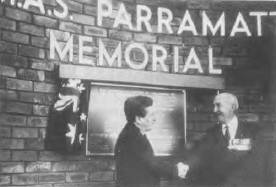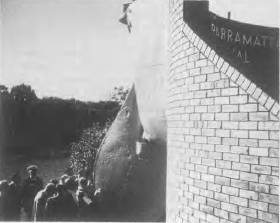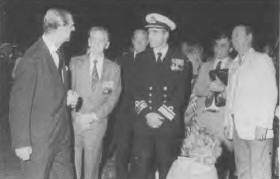- Author
- Lind, L.J.
- Subjects
- History - general
- Tags
-
- RAN Ships
- None noted.
- Publication
- December 1990 edition of the Naval Historical Review (all rights reserved)
Traffic on the main road was close to peak hour and to head west it was necessary for us to stop both traffic lanes. When the low-loader turned into the correct lane it was discovered the load occupied all of one lane and half the other. Progress halted while the police halted all traffic half a mile away in both directions.
It was 7.35 am when progress was resumed. Half a mile along Victoria Road we met an obstruction which could not be lifted. It was a concrete pedestrian bridge which spanned Victoria Road at the Rydalmere Mental Hospital. PARRAMATTA was fifteen inches too high to pass underneath.
Another long delay ensued while the position was considered by the police. The answer was supplied by the Society eventually. A delivery road led into the Mental Hospital and was provided with an exit fifty or sixty feet past the pedestrian bridge.
We were fortunate the Parramatta Council had taken out a large insurance policy against property damage. The heavy double wheels on the low loader chewed up both the lawn and garden and on one sharp turn at the back of the hospital the corner of a building was damaged. The inmates of the hospital had been evacuated beforehand and they appeared to derive considerable pleasure from the operation.
The pedestrian bridge was our last big obstacle. We arrived at the Council Depot at 9.20am, our path marked by the broken limbs of trees and shrubs which lined the streets.
In 1974 the Society published ‘HMAS PARRAMATTA 1910-1928’ by L.J. Lind which was officially launched at the Parramatta Returned Services Club by Commodore J.L. Merson, RAN. The book stimulated further interest in the memorial project.
Financial problems dogged the project for the next three years but in 1976 the Council discovered a grant which may cover the setting up of the memorial. A site had already been selected, Queen’s Steps on the banks of the Parramatta River downstream from Church Street. This site was significant for it was here that Captain Phillip had landed on his first visit to the settlement of Parramatta.

The Council planned the memorial would be a part of a hovercraft terminal which would link the city with Sydney. A design firm, Clasp Australia Pty. Ltd was engaged to prepare suitable plans. These plans were approved in 1977 but some doubt on the feasibility of the hovercraft service caused further delay.
We were kept well informed with the progress of the project by member Vic Walters whose confidence in the Parramatta Memorial never flagged. (Vic passed away earlier this year.)
By 1980 the hovercraft terminal project had lapsed and the plans were modified to a simple landing which gave access to steps which passed under PARRAMATTA’s outboard rudder before arriving at a grassed and gravelled viewing area which have pleasant views of the river over the destroyer’s foredeck. The design was magnificent and the many thousands who have visited it over the years have agreed it was one of the finest naval ship memorials in Australia.

The memorial was officially opened in brilliant sunshine by Admiral Sir Victor Smith, KBE, CB, DSC in 1982. An estimated 2,000 people attended the ceremony which was followed by an excellent luncheon provided by the Council.
Parramatta City Council never wavered from their original decision in supporting the project.
HMAS Parramatta – The Bow
The bow section of the old destroyer was returned to the Navy Depot at Rydalmere and there it remained until a further project could be planned. In 1984 I suggested to the General Manager at Garden Island it would be fitting for the bow of the RAN’s first ship to be mounted on the eastern point of Garden Island. This proposal was referred to Canberra and later that year the sum of $5,000 was allocated for the project.
Initially the site for the memorial was against the cliff face but the Department of Housing and Construction favoured a site at the water’s edge. Various plans were drawn up but no action was taken.
The subject was again raised with Rear Admiral Nigel Berlyn, AO in late 1985. I proposed 1986, as the 75th Anniversary of the foundation of the Royal Australian Navy was the ideal time. Construction commenced soon after and the Society was involved in the wording of plaques, etc. A last minute addition to the plan was two small plaques and trees to commemorate the second and third ships of the name to serve in the RAN.
When the question of who should be asked to officially open this second memorial I suggested HRH the Prince Philip who was attending the 75th Anniversary celebrations. The proposal was passed on to Canberra but was declined on the grounds that the Prince’s programme would be too heavy.
Our disappointment at this decision was passed on to a friend in England which resulted in a last minute change in the Prince’s programme. The unveiling of the HMAS PARRAMATTA Memorial at Garden Island became the first item on the Prince’s visit programme.

L to R: Prince Philip, Mr Lew Lind and Rear Admiral N.R. Berlyn, AO, RAN.
The unveiling ceremony was held at 6.30 pm on Friday, 3 October 1986 and was attended by several hundred members of the Society and the crew of the present HMAS PARRAMATTA provided a guard of honour. His Royal Highness was met by Rear Admiral Berlyn and myself and all members of the Committee were introduced. A comment by Prince Philip when introduced to our Honorary Legal Officer, Mrs Jenny Farrell, set the theme for a delightful ceremony. The Prince said: ‘It’s no wonder you have so many members when you have such a beautiful person as your legal officer’.
And so the Society’s first, largest and most enduring project was accomplished. The public image of the Royal Australian Navy had been promoted and preserved for the present and future generations in the two memorials to our first fighting ship.




